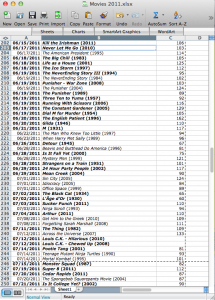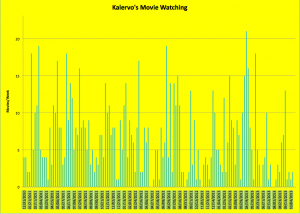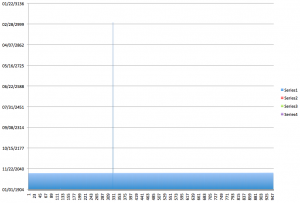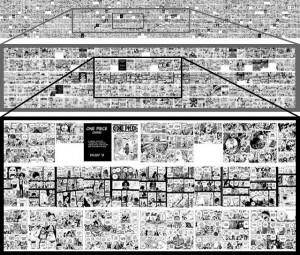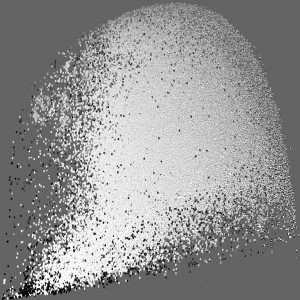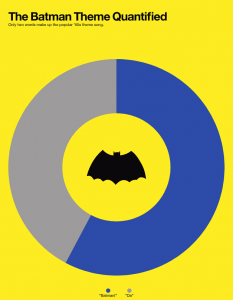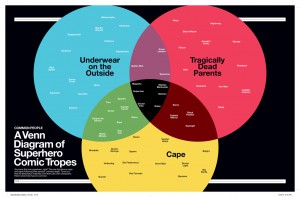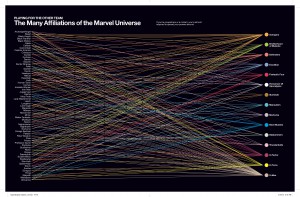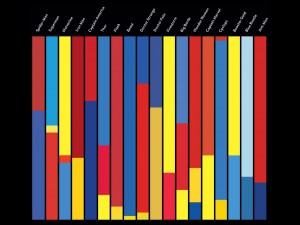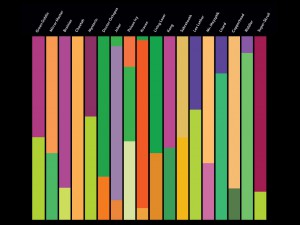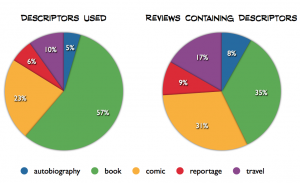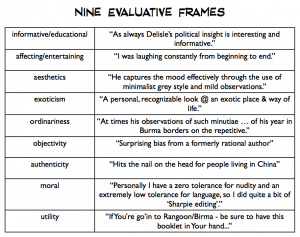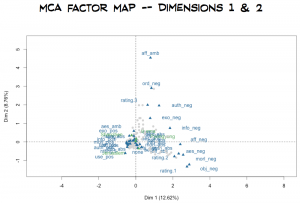The post Boot Camp: My Sad Life, Quantified appeared first on &.
]]>Journalling takes us back some years to the emergence of the middle class, mercantiles documenting many of the more banal aspects of their day-to-day lives in keeping with the running of their households and businesses. Daniel Defoe elevated record-keeping to an art form with Robinson Crusoe, most of which is taken up in detailing inventories and explorations across the shipwrecked protagonist’s dessert island. At a certain point, personal archiving became the exclusive realm of those with the time and resources of a cosmopolitan upper class who knew they were already going to leave a mark on history: take for instance presidential libraries or Margaret Atwood’s meticulous preservation of everything she writes from manuscript drafts to correspondence to grocery lists. Today, everything is digital and automated, and the middle class is right back to journalling without even realizing it by way of life-hacking: we let apps and websites keep track of what we do in an effort to learn more about our own habits. Which brings me to me. Over the last few years, I’ve begun keeping track without understanding why. Earlier this year, my mother-in-law gave me a Fitbit One activity tracker that monitors my exertions, calorie intake and expenditure, and sleep quality; and since 2010 I’ve been using Shelfari to keep track of what I read (it used to be a lot of novels, and then I went back to graduate school and almost exclusively became theory and comics). But all of this is trumped by my great shame: for the past three years, I’ve been keeping a spreadsheet of all the movies I watch. And it’s a lot. (fig. 1)
(figure 1: a random sample of my movie watching habits. I could tell you a hundred things about how these records relate to each other)
Before I explain how this spreadsheet works, full disclosure: in the past 1,027 days (January 1st, 2011 to today), I’ve watched 951 movies. That’s not too embarrassing: it averages out to 1.079 movies a day 7.559 movies a week. Respectable, if only it was actually one movie a day and seven and a half movies a week. Instead, it ends up being zero movies some weeks and more than 20 other weeks. But I’m getting ahead of myself. The spreadsheet is simple: column A is the date I view a film, column B is the title and release year of the film, and column C is the film’s running time. A bold entry indicates if it was my first time seeing the film in question. In 2012, I start keeping a fourth column, D, that I mark if I saw the movie in theatres (in 2012 I saw 312 movies, only 12 of which were in theatres, and I didn’t start using Netflix until this summer, so I’m a dirty pirate). This chart alone is interesting to me, in that I can observe a thought process running throughout it: one actor or director leads to another, or seeing a particular genre film will remind of something along the same lines I haven’t seen in years. It’s a bit like Moretti’s flow of novel genre: some subtypes subtend toward others, which eventually supplant them.
It wasn’t until a few days ago that I realized I should be writing my boot camp exercise about my own movie-watching habits, so I scrambled to learn enough about Excel to turn this spreadsheet into a histogram (fig. 2):
(figure 2: My movies per week for over 140 weeks. For a larger image click this: Kalervo’s Movie Watching)
It’s amazing what this chart tells me. I can connect huge spikes to times when I was doing a lot of writing or non-lit review research tasks (I like the background noise and must have ground through half of Hitchcock’s library writing a draft of my MA project in March of 2012), and I can connect drops to times in my life where I was otherwise occupied (the two biggest gaps are in late April of 2012, right after I finished my Master’s degree, and July/August of 2013, the month I got married). I can actually track major events, turning points, and trials in my life, just from the amount of movies I watched.
This was not easy. If the main point of these exercises is learn to do new forms of research, then the process of creating this histogram tells me a lot about how I should be doing things different in keeping my records, making my spreadsheet. For starters, Excel did not like the date format I was using. Getting around that took some time, and the first time I tried to put everything into a chart it came out a horrid mess (fig. 3):
(figure 3: my first attempt at a chart. Note the date range: 1904-3136. What?)
Secondly, bolding entries for new movies is useless in creating a visualization: Excel doesn’t recognize bold. I should have had things separated out a whole lot more: One column for title, another for year, another for if it was my first viewing of the title. If I had had just two extra columns, virtually no extra effort in the moment I create the record (as I was already adding year and newness, just not in different columns), I could have known a host of new things, from the time of year (if any) I tend to see new movies to what release years my viewing habits tend to favour. I can go back now and do that, but what would have been cake at the time is extremely tedious to do all at once now. And if I’d been more diligent in recording running times, I could have visualized total minutes spent watching movies as well (though frankly I’m relieved not to be able to show you that). It also wouldn’t hurt me to jazz the infographic up a bit. I’m far from Nicholas Felton’s annual Feltron reports in my aesthetic (see featured image), and while up until now I’d always appreciated him as a graphic designer, I imagine he must have quite a bit of programming know-how too in order to predict the kind of things his programs would expect from him in terms of valid input. The demystification of the process is also remystifying: while I know now bolding entries was not helpful, I’m not sure the ideal value to put into my new column for newness.
In any event, I’m actually extremely impressed by how useful this record can be about telling you about me. In quantifying myself and my habits, I also quantify a corpus of texts according to my own biography. And while I hold no illusions that I’ll be interesting for future generations of scholars, it gives an organizing principle to my every action. Everything we do when we journal and archive ourselves is imbued with extra meaning. How that meaning values for others is less important than the intrinsic value we can see for ourselves in our own lives lived.
The post Boot Camp: My Sad Life, Quantified appeared first on &.
]]>The post Probe: Infographics for Graphic Lit appeared first on &.
]]>What kinds of graphs and topologies exist for works in the comics field?
How can quantitative data gathering allow us to perform qualitative analysis?
What work do charts and graphs perform on other media, as media themselves?
I had a difficult time writing this piece. I knew what I wanted to use, but I wasn’t quite sure what to make of my object. Much like a topological analysis, the data was all there, but it was on me to decide what to do with it. In this week’s readings, our thinkers focus in on macro- and micro-cosmic views of literature: Moretti on the large sea changes of genre and trend over time, Piper on the recurrent aspects of language in individual oeuvres. I admit closing my laptop just a little frustrated–both had focused on easily extrapolated data (well, perhaps easily is not the right word so much as simply). Where, I thought, were the topological and graphic representations of works that are constituted by a more nuanced system of signs, such as brushstroke, paint viscosity or movement? Even better, where were those that performed readings of inherently intertextual media, where more than one system of signs is at play at all times? This is the kind of thinking that’s led me directly into my research focus. For the past two years, I’ve been part of a research team (along with Darren Wershler and Shannon Tien) studying the habits of underground comics scanners, digital pirates who disperse comics online via bitTorrent sites and file lockers. A big part of our project has been backtracking through almost a decade of illicit uploads to interrogate the rhetoric of both the groups themselves and the large corporations who decry media pirates as predatory profiteers. We have initial findings out in Amodern with more research pieces on the way, but it’s taken us a long time with limited resources. I think part of what excites all three of us about the project is that when we performed our literature review, there didn’t seem to be anything else out there like what we were doing in comics studies. But a lot changes in two years, so I’ve decided to take this opportunity to look at topologies and quantitative methods of analyzing comics–those few that exist–to see how well graphs can represent the simultaneously textual and graphic.
When Friedrich Kittler talks about media, he often frames them in terms of their functions, functions he lays out as recording, storage, and transmission. How do infographics and charts work as a medium, on other media? Recording here means the gathering up of simultaneity in visual form; storage refers to the overlaying of different temporalities and cycles in a single measure; and transmission we can think of in terms of circulation as proposed by Gaonkar and Povinelli. So these charts then are conduits for the data they contain, but can also be seen as powerful tools for shaping data itself and the cultures that produce and consume them. Following Madeline Akrich, I want to argue that technical objects like charts and graphs participate in building heterogeneous networks that bring together actants of all types and sizes, whether humans or nonhuman (Akrich 206). To this end, I think we can use quantitative methods to make qualitative statements not just about content and form (as if those weren’t enough), but also about cultures of exchange and the ideological protocols underlying cultural production.
Take for example the One Million Manga Pages Project. This ambitious endeavour downloaded content of almost 900 manga series available as ‘scanlations’ (fan-translated and digitally circulated Japanese comics) on onemanga.com (as well as user-generated metadata like genre demographic tags) and then began using supercomputer-powered custom digital image analysis software to detect trends and variations in the graphical languages of manga. (Manovich et al 192). The One Million Manga Pages Project is not just geared toward analyzing the tropes of manga qua manga; it’s also directed at using this initial large data set as an exemplar for future digital humanities research. At the same time that the project is striving to make qualitative statements about manga as a culture industry, however, it’s also necessarily gathering information about the circulatory practices of manga in fan communities. By doing something as simple as examining the quality of scanned pages and then cross-referencing the types of series being scanned, the project can try to identify the common features of scanlation culture and manga itself simultaneously without depending on expressions of rhetoric that are undoubtedly biased. As the saying goes, a picture never lies. An easy finding? In figure 1 we see how black indicates the ‘credits page’ scanlators attach to their translated and scanned files, while white points towards manga tropes of two page splash spreads and black border indicates the occurrence of flashbacks. Now that the tropes are positively identified, it’s much easier to pose questions of why and how.
(figure 1: zoom ins of the One Piece visualization, a grid composed of some 10,461 pages. Manovich et al. 208)
But what does a million pages of fan-translated and scanned manga actually look like? Again, it depends of the kinds of questions you want to ask. Here they are when what you want to know about is the contrast of texture and color scale (fig. 2):
(figure 2: 1,074,790 pages of manga graphed where the vertical represents articulation and the horizontal represents the range of grey tones. Manovich et al. 222)
Here the quantitative question pertained to how gradations of gray tones related to fine texture and amounts of detail. The vertical (Y) axis charts the increasing use of fine linework on a page on the ascent, while the horizontal (X) axis charts the diversity of gray tones on the page with the right trajectory indicating nuance. From here, the project can ask all sorts of qualitative questions, from questions of the ‘style space’ to whether or not distinct and systematic visual differences exist between mangas created for different ages and genders (Manovich et al 223).
While massive data sets can give us knowledge about comics technique, it only takes one person with a large collection and a creative eye to visualize comics content in an revealing way. Graphic designer Tim Leong’s Super Graphic consists largely of entertaining topologies (fig. 3) and selective and somewhat subjective fan service (fig. 4), but also contains a lot of useful reference material for sorting out comics content. From disentangling decades of convoluted continuity in one chart (fig. 5) to identifying the color tropes of morality in mainstream American superhero comics (fig. 6), Leong may have, however inadvertently, created a useful reference handbook that can help guide not only scalar readings, but close readings as well.
(figure 3: Batman theme quantified. Leong 34)
(figure 4: superhero venn diagram. Leong 12-13)
(figure 5: Marvel hero affiliation chart. Leong 74-75)
(figure 6: apparently, good and evil are a matter of primary and secondary. Leong 10-11)
These quantitative scalar methods are also being used to analyze reception of comics works, which in turn can help us figure out how we want to go about generically categorizing works in a field that has always proven notoriously difficult to classify (Delany 1999, Meskin 2007, Groensteen 2006). Comics scholar Ben Woo has performed a study of Quebecois cartoonist Guy Delisle’s oeuvre using Amazon.com reader reviews to see how audiences collectively aggregate description. Poring over reviews of Delisle’s books looking for descriptors (fig. 7), Woo was able to build evaluative frames that he then charted in a multiple correspondence graph where proximity is based on similarity (figs. 8-9).
(figure 7: reviews of Guy Delisle’s books sorted into genre descriptors. Woo slide 8)
(figure 8: the evaluative frames Woo generated based on the reviews he examined. Woo slide 12)
(figure 9: this multiple correspondence analysis of Delisle reviews has allowed Woo to observe that those who dislike Delisle’s work have a higher variation of reasons for doing so than those who enjoy the books. Woo slide 14)
This allows us to gauge the trackable response to Delisle’s work based not on official press reviews or a simple metacritic number, but instead on the classifications made by casual readers, evaluations Woo has even been able to sift into areas based on ambiguousness of commentary and positivity indexes. In figure 9, we can observe that negative or lukewarm reviews are more varying from one another than the positive reviews, which are very tightly packed close to the origin in the lower left. This type of research allows us to make both statements of individual stories and the formal qualities of opinions made within certain communities.
While it would be nice if these examples represented just the tip of the iceberg of serious investigations into graphing and charting comics, it actually comprises the bulk of the investigation out there. Still, I’m disappointed. I have yet to find any form of surface reading that allows for analysis of both the textual and graphic content of comics simultaneously. Again, I’m left wondering if more perfect forms of analysis might exist. Certainly the project best suited to such a task is the One Million Manga pages endeavour, which could perhaps augment its programming to include the translated textuality of the scanlations it studies. Still, it’s clear that graphically representing these objects reveals a great deal about both the ways that the texts are produced and our own habits in actively consuming them. Moreover, it seems that this form of surface reading actually also allows for some depth analysis, even if that analysis doesn’t necessarily follow along with a hermeneutics of suspicion.
Works Cited
Akrich, Madeline. “The De-Scription of Technical Objects.” Shaping Technology/Building Society: Studies in Sociotechnical Change. Ed. Wiebe E. Bijker & John Law. London: MIT Press, 1992.
Delany, Samuel R. “The Politics of Paraliterary Criticism.” Shorter Views: Queer Thoughts & the Politics of the Paraliterary. Hanover: Wesleyan University Press, 1999.
Gaonkar, Dilip Parameshwar, & Elizabeth A. Povinelli. “Technologies of Public Forms: Circulation, Transfiguration, Recognition.” Public Culture 15.3 (2003): 385-97.
Groensteen, Thierry. The System of Comics. Trans. Bart Beaty and Nick Nguyen. Jackson: University Press of Mississippi, 2007.
Kittler, Friedrich. “The History of Communication Media.” Global Algorithm 114 (1996): n. pag. Web. 16 October 2013.
Leong, Tim. Super Graphic: A Visual Guide to the Comic Book Universe. San Francisco: Chronicle Books, 2013.
Manovich, Lev, Jeremy Douglass, & William Huber. “Understanding scanlation: how to read one million fan-translated manga pages.” Image & Narrative 12.1 (2011): 190-227.
Meskin, Aaron. “Defining Comics?” The Journal of Aesthetics and Art Criticism 65.4 (2007): 369-379.
Moretti, Franco. “GRAPHS, MAPS, TREE: Abstract Models for Literary History – 1.” New Left Review 24 (2003): 67-93.
Piper, Andrew. “Reading’s Refrain: From Bibliography to Topology.” English Literary History 80 (2013): 373-399.
Wershler, Darren, Kalervo Sinervo, & Shannon Tien. “A Network Archaeology of Unauthorized Comic Book Scans.” Amodern 2 (2013): n. pag. Web. 14 October 2013.
Woo, Benjamin. “‘Maybe they’ve mixed me up with Joe Sacco?’: Reportage, Autobiography, and the (non-)Touristic Gaze in Guy Delisle’s Graphic Travelogues.” New Narrative VI: Seeing is Believing. Unpublished conference paper. 2013. University of Toronto, Toronto, 2013.
The post Probe: Infographics for Graphic Lit appeared first on &.
]]>The post 9-22-2013 How to make a scene appeared first on &.
]]>This week in my textual analysis class I had to read an old piece by Will Straw about communities and scenes in pop music (“Systems of Articulation, Logics of Change: Communities and Scenes in Popular Music”). Though I had a bit of trouble at times following the trajectory of the argument, I think I caught onto at least one important aspect of the piece: it seems that historically, music studies have prized the idea of music coming out of various geographical cultural communities, but from Straw’s perspective it appears that the methods of circulation are just as meaningful and telling as the geographically circumscribed communities from which the music emerges. Even in the early 90s, the centre was disappearing from the way that musical styles coalesce, with stylistic changes beginning to appear to be more the result of individual rather than cultural efforts. One interesting element coming out of this reading of pop music culture is the after-the-fact creation of points of reference—at one point Will makes mention of ‘moves’ in dance-music culture being constructed as historical trajectories only after the successes floated to the top, producing ‘little rationality beyond the retrospective sense of appropriateness produced by their success.’ (374)
In challenging these tropes, the piece is clearly tied in with a postmodernist end of history, leading me to wonder: do the changes in the generative tools of history that have occurred in the more than 20 years since this was written–data tracking, observable circulation strategies, and other metrics–also challenge the idea that history is constructed after the fact? On the other hand, certainly the creation of ‘scenes’ still relies on a constructed sense of history, of ‘I was there first.’ It seems to me that we construct our musical cultural capital less from saying ‘I saw them when they played at this place‘ than from saying ‘I saw them before they were big’—tying the capital less to geography than circulatory articulation (learning of a band through word-of-mouth over learning of a band from mass media outlets like TV or the radio).
Anyways, it’s an interesting question. Coming up this week, I’ve got plenty of writing to do on the Cambridge draft and we’re having our second IMMERSe meeting. No idea yet what kind of weeknote’ll come out of such a harried handful of days.
The post 9-22-2013 How to make a scene appeared first on &.
]]>The post 9-14-2013 IMMERSe meeting #1! appeared first on &.
]]>So this past Friday marked the first meeting of our IMMERSe research project team. IMMERSe, if you’re not familiar with it, stands for the Interactive and Multi-Modal Experience Research Syndicate. As the website will tell you, it’s a SSHRC-funded project (research network, really) that aims to uncover new knowledge about the production, circulation, and use of games, taking in a number of interdisciplinary perspectives. The network is doing all sorts of cool stuff, but the specific area we’re taking on at the Concordia branch is narrative and dialogue in games. Amongst other questions, we’re going to look into the narrative affordances unique to games, the process of writing for games, and the trajectory of transmedia narrative as it enters or leaves games. The whole thing is pretty exciting, and it’s been a while getting it organized. The Friday meeting was mostly to discuss our first project under the auspices of the IMMERSe umbrella–the kind of successful brainstorming session that goes on for several hours and still manages to get focused at the end. Our team consists of Darren, Bart Simon, Stephen Yeager, Carolyn Jong, Rob Gallagher, and myself.
So what is this project going to be? Without giving too much away, we’re going to start by putting an eye on (primarily) narrative mods in Bethesda‘s aRPG Skyrim. You remember, it was like a crazy big release a few Decembers ago:
We kind of already had it in our heads that we were going to do some research on Skyrim mods before we sat down: Carolyn has done some really cool work on the subject already, so we figured we’d huddle around that and see what we could make happen. The idea is to start off with a low-level problem or research question (by which I mean general, not unimportant), spend a few months researching the hell out of it, refine and distill our aim into a few more research questions, and then pound out a couple of papers. We want to find out what mods do, to the gaming experience, the narrative, performance, culture…we covered a lot of ground in the meeting, but some of the highlights include the notion of modders as scribes (thank goodness I took that course on archives and manuscripts with Stephen a few years back), modding as a form of prosumption or overconsumption (the Deleuzian difference in desire between taking a product and trying to build something with it and building something with a product because your need to consume it goes so far beyond what’s provided), and the idea that the magnitude of a fictional world might be provocative of the kinds of modding performed.
As I said, it’s exciting. We don’t know just what the project will be yet, but I’m utterly stimulated by the beginning of something that will last and develop through at least the next year of my life. The last time I started something like that, it was the comics piracy research project, and I didn’t really have any sense of how far down the rabbit hole that endeavour would take me (when Darren had me start collecting data in January of last year, I figured we’d be writing by March and finished by June). It’s a good team, and we’ve started off by setting some low pressure, manageable goals based around some of our discussion. It’s adding a lot of extra work to my term, but I think it’s just enough that I can handle it. As the project manager (yeah, I was surprised too), quite a few of my weeknotes in the upcoming months may take on the look of project blog updates–my way of killing two birds with one stone.
The post 9-14-2013 IMMERSe meeting #1! appeared first on &.
]]>The post Boxes Probe appeared first on &.
]]>Hi Distant Readers,
Last week Darren talked a bit about a probe I created a few years back on imaginary media forms. I thought I’d toss up an edited version as an example of where probes can go if they focus more on creation than research. Comments, criticisms, and assorted thoughts welcome! Photo credits go to Katie Sehl; the other models in the probe are Katie and my wife.
The post Boxes Probe appeared first on &.
]]>The post 9-7-2013 21 months of the comics piracy research project appeared first on &.
]]>It was close to two years ago that Darren approached me to ask if I was interested in RA work looking into the culture of digital comics piracy. When I think about it, that span of time is the longest I have ever spent directly addressing one central research question or topic, and not without reward: in addition to the skills I’ve developed and publication lines I can now look forward to having on my CV, I’ve also managed to become an authority on the subject of illicitly produced and trafficked comic book scans. I thought it might be nice to take stock a bit this week by writing some about the evolution of this project from late 2011 up until now.
When I joined the project, it really just consisted of Darren, a few research questions about comic book scans and scanners, and a handful of screen grabs from torrent sites like The Pirate Bay and Demonoid. “The first step,” Darren told me, “is to gather data. Any day now these sites are all going to be shut down and we’ll lose all the data.” My job was to collect records of as much of the activity from a few main pirate groups as possible using Paparazzi! or print save. This wasn’t too hard in principle: comic scanning crews operate on a more or less organized schedule, with weekly upload packets that also seem to track the activity of independents. For any given week, I had to find one-three records held on a torrent site’s webpage with the relevant information about what was in the torrent file in plain text. Now, when looking for contemporary records (e.g. weekly uploads from 2010-2012), this was simple enough. But the further back I went, the rougher it was to find evidence of scanning crew activity, and the more disorganized that activity became. Meanwhile, Darren would shoot me emails with links like these, urging me to hurry up, because any day now we were going to lose access to everything. I found myself Googling deeper and deeper, visiting stranger and stranger torrent sites, and viewing pages that probably hadn’t been seen in years. But it was worth it. Over the course of about a month, I managed to find more or less consistent weekly records stretching all the way back to the early months of 2005, which is the earliest evidence I ever managed to find of any organized comics piracy. My eyeballs were bleeding, but I was pleased with myself.
For the next phase of the research, Darren brought Max Stein in to help us organize this mountain of data. We figured we would start by inputting all that we had into simple Excel spreadsheets with a few important fields: date uploaded, title of comic, issue, volume, year of publication, format note, scanner name(s), crew, uploader, size of torrent file, language, and any extra comments I might have. Max was instrumental in help automate the process–he took these hundreds of PDF files representing tens of thousands of lines of information and converted them into plain text files. Suddenly, I no longer had to re-write every single entry; instead I could just copy and paste.
Still, the process took months. Shannon joined the project, and together we spent the summer taking on the arduous task of transcription. This was the most gruelling part of the job, but it was still a great job–part of what I was getting paid to do was think critically about comic culture! By about this time last year, the grunt work was done and Darren had lined up a few writing gigs for us. I thought we would dive right in, but it would be months before we started creating a draft. First came the literature review.
But I’m probably approaching the limit of what should go into a single weeknote, so I’ll just have to say to be continued. Meanwhile, this week saw a return to school, and the semester looks like a hectic one already.
The post 9-7-2013 21 months of the comics piracy research project appeared first on &.
]]>The post 31-8-2013 Tools appeared first on &.
]]>I believe we’ve already talked a bit about the digital comics piracy project and, more pertinently, about the digital comics chapter for the Cambridge University Press global history of comics book. Our research team took about a month away from meeting and working directly as some of us got married, some of us got jobs, and some of us taught our kids to swim/prepared a full course load and God knows what else for the fall. But now we’re back in it, and trying to figure out how to make our divergent schedules work in writing a chapter that has too much material for too little space. This week I thought I’d write about some of the tools I/we have used in the past 20 months in researching and writing our various pieces connected to digital comics.
Paparazzi!: This simple utility just makes screen shots of webpages. That’s all I use it for. This tool is brilliant for quick info capture as first experienced online. I was able to speedily gather page after page of torrent info for later transcription into spreadsheets. Paparazzi! was perfect for most BitTorrent sites with the exception of Kick Ass Torrents, which tends to make you expand a field in order to see all the listed info on the torrent. For torrent info accessed through KAT, I would have to do a print save.
Time Edition: Back when this project was just research without any publication opportunities, Darren had me on the payroll as a research assistant. For the first eight months or so of digital comics research, I had to manage my own schedule and keep my own hours so as to know how much I’d gotten done. Time Edition is a handy little app that lets you do just that–it’s as simple as a stopwatch with two little extras that make all the difference: one, it allows you to categorize how you’ve spent a given chunk of time into client, project, etc.; and two, if you get up and walk away from your computer for more than five or ten minutes, it clicks off and sticks a pop-up-alert on your screen. So you can avoid leaving it on all night or working for several hours without any records to show for it.
Skype and Google Hangouts, of course: We couldn’t always get together in the & Lab to discuss our progress, and tools like these allowed us to get things done while in different time zones (or just feeling too lazy to trudge through the snow to Concordia). In an interesting first for me, I actually trained Shannon in our data collection methods via Skype when she came on board the project a few months in (I was in Toronto).
Dropbox: Oh Dropbox, you complete me–or at least you complete my shared data cloud. Dropbox has been more or less the crux of all our research: with a little bit of organization we were able to update each other constantly. The only pitfall is conflicted copies created by two people working on one thing simultaneously–a problem corrected by
Trello: If you’re involved in a group project and not using Trello, here’s the solution to many of your frustrations. In essence, Trello is an online bulletin board made up of columns where you can have categories like To Do, In Progress, Completed, In Review, and so forth. Everyone on the team has access to the Trello board, so if you start your project by dividing it into tasks, you can use the board to make sure something is always happening, no redundancies are occurring, and no one is ever waiting to be given something to do. We’ve been using Trello for research and writing, but I also intend to utilize it for conference organizing this year.
Draft: We’re just about to start using Draft after DW presented us with a number of options for how we could edit each other’s work without sending a million emails back and forth or creating any conflicting copies. We haven’t gotten into it too deeply yet, but right now Darren is loading our outline into it. Trello will make sure no two people work on the same thing at once, while Draft should ensure that no useful edits get lost in the mix.
These are just the essential ones that come to mind and aren’t necessarily all that obvious (Certainly MS Office doesn’t need me advertising for them here). It occurs to me as I type this that I have yet to write a weeknote about the actual research processes we’ve employed over the last year and a half+. Now that I’ve gone over some of the tools, maybe next week I’ll talk about the actual evolution of the project–provided the start of the semester doesn’t give me something I just have to write about first.
The post 31-8-2013 Tools appeared first on &.
]]>The post 25-8-2013 – The proper context, the proper connections appeared first on &.
]]>Last night I went with some people to the Critical Hit final Showcase at Google Montreal. I mentioned CritHit in my last post, but I’ve been on and off following the serious games collaboratory since it began a few months ago. The incubator’s last playtest was only a couple of weeks ago, and I was amazed to see how much work all the developers had gotten done in just 14 days–bugs were fixed, graphics were greatly improved, some were sporting almost whole new soundtracks (the fact of this impressive amount of work being done in such a short amount of time only lends credence to claims of efficacy and necessity for institutionalized crunch time in the games industry, but that’s a whole other post). Of these games, probably the most fully formed, or at least the most easily encapsulated in a short demo playtest, was one called War Agent. Somewhat reminiscent of MolleIndustria‘s McDonald’s Videogame in pace, War Agent is a flash-style simulator where you learn about the human costs of arms production, as well the political and industrial ins and outs of international conflict. The game was addictive, compelling, frustrating–it had all the elements needed to for an excellent ludic experience. But did it drive home its points, whatever they were? On the walk home, I got into a conversation with my wife and our friend about how effective a serious game can be. It was pointed out that the meaning of such a game could be lost on an experienced gamer trying more than anything to play optimally and “win”–we had watched one expert player totally crush it at War Agent, but he was definitely not reading the ticker tape at the bottom of the screen that communicated the ideology behind the game in the form of news briefs and fatality statistics. At the end of the experience, only three numbers were important to the player: civilian casualties, fighter casualties, and profit. At the end of his playtest, the expert player said, “Oh great. I made x number of dollars and only lost y number of lives.” A ten year old kid ran up and proudly proclaimed, “That’s nothing! I made double that profit and only killed three-quarters as many people!”
This anecdote lead us into a discussion of who serious games are for and why they’re made. Certainly not a lot of weapons manufacturers are likely to walk away from playing War Agent and renounce their wicked ways (it’s possible, but to claim that as the game’s ultimate or central goal would be terribly naive). And as a tool to only bolster already existing support for a certain cause, it seems a little elaborate and unnecessary. Then we can look at the two types of players we had observed playing War Agent–one, a seasoned games scholar who sits down in front of game and immediately starts looking for ways to play the best game possible, and the other a kid who is just looking to have fun by interacting with the system, and can pick and choose what to pay attention to in the simulation (and if growing up in the world of the PSA has taught me anything, that kid was only looking at the blood and guns and mooing “coooooool”).
So who is the serious game for? One of the answers, in my mind, is educators and the people they teach–those at the stage of life where they’re just developing their critical thinking skills and a game format, along with the context of discussion before and/or after play, can be truly eye-opening and life-changing. The developer of the serious game, however, needs to find that razor-thin balance between being didactic and letting the gameplay totally drown out the message (in my experience, most advocates of a cause who try to develop a game fall into the former category and most developers who want a cause for their game fall into the latter–there were definitely some games at Critical Hit where the ideology behind the creation was obfuscated by the fact that the developers wanted to make a fun, beautiful, or marketable game more than anything else). It’s up to the developer to walk that tightwire, and then up to the presenter of the game to bring in the context, and finally it’s the opportunity for the player to make connections. It’s always going to be an opportunity easily missed (I think I learned a ton of history from playing Assassin’s Creed III, for example, but I had to practice constant diligence to do so). I’d be interested finding out just how much serious games are being used in the classroom. Many of those that I’ve played seem to do an excellent job of walking the tightwire, but then most of the serious games I’ve played align with my own politics. I already had my mind made up before I played, you see. So yes: actually making the serious game is only half the battle. The other half is not just getting them out there, but getting them out there to where they can have the strongest impact.
This week I continue my reading of First Person–the book is really starting to whet my appetite and get me excited to begin work on IMMERSe-related projects regarding narrative in game, game as narrative, narrative as game, and all the other controversies and overlaps between the two. I think for my next note I’ll have an imaginary debate with Espen Aarseth.
The post 25-8-2013 – The proper context, the proper connections appeared first on &.
]]>The post 11-8-2013 Responses to Algorithmic Culture appeared first on &.
]]>So I just finished reading Alexander R. Galloway‘s book Gaming: Essays on Algorithmic Culture. When it comes to game studies, I often consider myself a little late to the game (pardon the pun), but I’m learning as fast as I can and my involvement in various projects, as well as my interest in discussing games in my dissertation project, ensure that I’ll be a playing in fine company soon enough. Anyways, Gaming was initially published back in 2006, meaning that most of the essays in the book predate things like Facebook games, smartphone and tablet games, and even the most recent generation of consoles. There’s still just loads to be taken away from this book–Galloway is spot on in his analysis of the ways that games function differently from other media by virtue of their need to be enacted upon to qualify as games. In essence, Galloway claims, video games are not interactive so much as they are action-based.
But what I really want to write about today is the final chapter of Galloway’s book, “Countergaming.” This chapter focuses on what Galloway calls the avant-garde of game design. He takes a look at the work of artists like Jodi, Tom Betts, and Brody Condon, and compares the countergaming aesthetic with that of the French New Wave cinema: basically, Galloway posits video game artists as striving to present pieces that scrape against the grain of mainstream game production. This was an especially interesting chapter to read seven years after the fact, because Galloway positions avant-garde gamic expression as almost inevitably a product of modding. Little room seems to be left in Galloway’s analysis for gamic art pieces that aren’t hacks of existing game engines where the system of rules, goals, or actions are being subverted in order to express something visually and thematically. He also suggests that such a movement is possible because the gaming industry endorses hacking and modding, which makes me wonder about how that relationship has changed since the book was published (IP being so much more a concern now than ever, and things like this have happened). Galloway wraps up the chapter by telling us that a) no true avant-garde of gamic action exists today, as countergaming is progressive in visuality but reactionary in actionality, and b) an independent gaming movement has yet to flourish (a is probably consequential of b here).
I wondering what Galloway has to say today. When Gaming was published, Steam already existed but had yet to truly revolutionize indie gaming. Now, I meet developers who are interested not only in creating fun, thematically serious games, but making every aspect of the ludic experience, from visual aesthetic to auditory experience to playing experience, an artistic experience. Sometimes, I think that all the indie game developers I’ve talked to care more than anything about pushing the boundaries of the form. And none of them are trying to do so by hacking or modding. And plenty of them are reaching out and affecting more than just a few hundred people: indie dev companies like Thatgamecompany or Giant Sparrow and incubators like Critical Hit look more like artist collectives and up-and-coming studio exhibitions than mass-media producing enterprises. But this isn’t news to you. You know we’ve been living in the bloom of independent gaming, and artistic gamic expression, for quite some time now. But cut me some slack: I’m late to this game.
The post 11-8-2013 Responses to Algorithmic Culture appeared first on &.
]]>The post 3-8-2013 On returning to work appeared first on &.
]]>So last week I offered no post–too busy getting married. As my wedding approached, I tried hard for a while to stay grounded and not get so totally swept up in the upheaval that my I lost my research footing. Then I surrendered to my own personal life and forgot entirely about work for a few days. Though I’ve now been married for almost seven days exactly, I still haven’t gotten as far back into work as I would like. Not only has my research suffered, but my organizational and administrative tasks as well. I thought it might help for my weeknote today to elucidate and illustrate some of what needs doing in my August:
Secure travel funding: Back in the spring I was invited to present a paper at a conference in Oxford, something I was only too happy to jump on top of at the time. Now the conference is just a month and half away, and I’ve only secured enough funding to cover the registration fee. The process of applying to a conference when you have an exciting idea for a paper is deceptively enjoyable: I remember seeing the CFP for this conference, fresh off the high of finishing a term paper, and pounding out a proposal in less than an hour. Now I’m not so daunted by the prospect of writing the paper as I am by the task of getting the money so I can go present it. Filling out various travel grant application forms is a full-time job, and each funding body want slightly different supporting documentation than all the others. I’m going to sit down and fill out all the forms, generate all the content, before I go to start printing off so I can sign apps and letters.
Get back into my reading: Before Weddingmageddon began, I was 80 pages into Alex Galloway’s (so far) great book on algorithmic culture, with another theory reader waiting in the wings to be picked up. It’s tough to motivate myself again–I’ve gotten used to sitting in an exhausted stupor–but beginning on Tuesday I’m reassigning myself a chapter a day so I can soak as much substance as I can from what little undirected time remains to me in 2013.
Start playing again: Right before the wedding, I was unwinding by playing a few hours here or there of whatever game was backlogged on my console. Now I can go back to playing a couple hours a day with my critical brain turned on. The hardest part of this will be striking the balance between not playing at all and blowing off all my other tasks (not to mention sunlight, nourishment, and my wife) so I can bank 10 hours of Dishonored.
Empty out my inbox: In my reality, productivity abhors clutter, so getting it all done starts with clearing out my inbox: responding to action items, foldering that which has been dealt with, and deleting Facebook notification emails. A lot of things are in danger of falling by the wayside, so spending an hour dealing with emails will put into perspective what’s important to keep up with and what I should really let slide.
There are lots of other tasks I could include in this list, but they’re either more individual line items (“edit section,” “submit advisor change form”) or not suited to the Amplab website (“do laundry”, “start writing thank-you notes,” etc). Hopefully this weeknote does what it’s meant to do and lets me see more clearly what needs to be addressed. We’ll find out next week–if it works, I should have something a lot more clear-headed and interesting to write about.
The post 3-8-2013 On returning to work appeared first on &.
]]>